Hong Kong is usually a poor place for seeing migrating birds of prey; on many days, you might be hard-pressed to see even one passing over. But on some days – and perhaps not every year, two species can be seen in good numbers: Grey-faced Buzzard (Butastur indicus), mainly late March and early April; and Chinese Sparrowhawk (aka Chinese Goshawk, Accipiter soloensis), mainly in the second half of April.
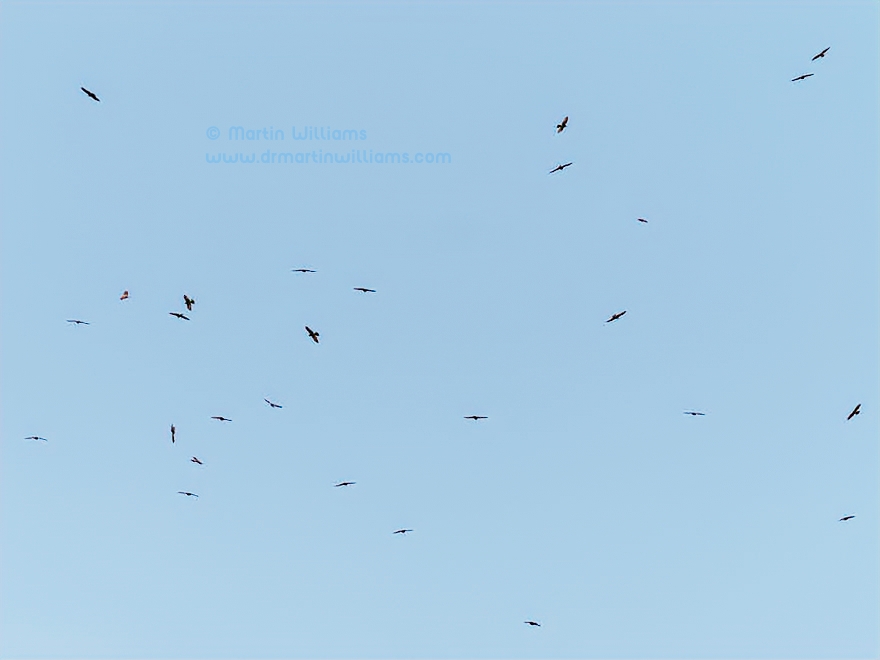
- Introduction
- Summary
- Waves of Grey-faced Buzzards and Chinese Sparrowhawks in late 1980s and early 1990s
- Migration Waves Predictable … sometimes
- Travelling the Oceanic – Ring of Fire – Flyway
- South China Coast Including Hong Kong as “Safety Net” for Raptors
- Amazing Morning for Chinese Sparrowhawks passing Po Toi
- Spring Raptor Watchpoints in Hong Kong
- Lantau a Hotspot for Raptor Observations in Spring 2022
- Why Windy Gap and Ngong Ping Area on Lantau?
- Notable Days for Grey-faced Buzzards and Chinese Goshawks in Spring 2022
- Island Rest Stops for Tired Migrants
- Other Birds at Windy Gap / Ngong Ping Area
Introduction
When I first arrived here, back in 1987 [!], it perhaps seemed the days with large numbers of these were somewhat random. But as I worked on a paper with Lam Chiu-ying – Weather and Bird Migration in Hong Kong, which was published in the Hong Kong Bird Report 1993, I found similarities in weather patterns for days with Grey-faced Buzzards or Chinese Sparrowhawks recorded in substantial numbers. In essence, these days were soon after cold fronts moving over Hong Kong, when winds over the northern part of the South China Sea had become northeasterly or easterly.
Before this, I had envisaged migrants passing over Hong Kong travelling along the coast from the southwest. But this similarity in weather patterns suggested these birds of prey were arriving from the east of Hong Kong – perhaps from north Luzon in the Philippines. Indeed, this would fit with information showing many Grey-faced Buzzards and Chinese Sparrowhawks follow the world’s major oceanic flyway for migratory birds of prey [raptors].
Summary
- Spring “waves” of Grey-faced Buzzards and Chinese Sparrowhawks passing Hong Kong coincide with easterly airstreams – surely as they are deflected west from the main flyway north of Luzon.
- This helps predict good days for seeing these birds, and other migrants.
- There is growing information on these raptors travelling the flyway, from Japan, Taiwan, the Philippines and Indonesia.
- South China including Hong Kong serves as a “safety net” for these birds when deflected westwards: can make landfall, then reorient and continue northwards.
- Waves of spring raptor migration have included an amazing morning for Chinese Sparrowhawks at Po Toi.
- Waves of these raptors have been seen over several sites in Hong Kong, mostly by birders watching for other migrants. These were typically coastal, lower elevation sites.
- In spring 2022, vantages high on Lantau proved good for these raptors.
- Indeed, spring 2022 proved good for these raptors, with spells of easterlies, mainly during what proved to be the driest April on record.
- It appears the Grey-faced Buzzards and Chinese Sparrowhawks may initially land on islands south of Hong Kong, perhaps during the night; then rest, and head north in mornings.
- The Lantau vantages have yielded other notable observations.
Waves of Grey-faced Buzzards and Chinese Sparrowhawks in late 1980s and early 1990s
Here are notable days for Grey-faced Buzzards and Chinese Sparrowhawks I found while looking through Hong Kong bird reports to find interesting migrant records, while working on the Weather and Bird Migration in Hong Kong paper (Weather and bird migration in Hong Kong 天氣與香港的鳥類遷徙活動):
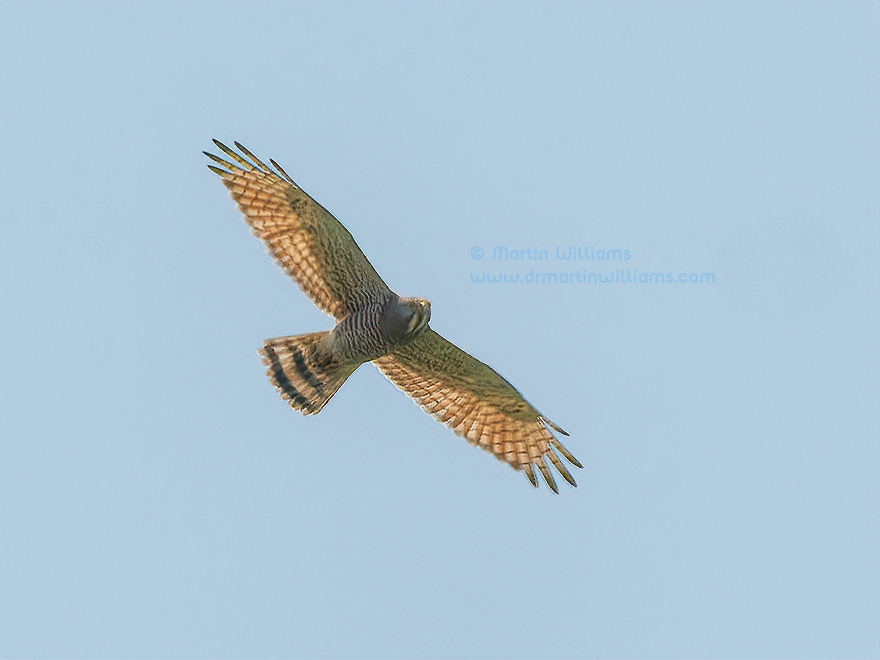
21st and 22 March 1993 A northerly surge had arrived earlier on 18th, bringing a temperature drop of around four degrees. Easterlies were replacing northerlies on 21 st and 22nd. It was cloudy but free of rain on 21st while there was a trace of rain on 22nd. Two flocks of Grey-faced Buzzards, totalling 98 birds, were seen passing north on 21 st: 42 over Cheung Chau and 56 over Aberdeen Country Park. The following day, some 228 were recorded heading north: 57 over Mong Tseng (Tsim Bei Tsui), 147 over Mai Po and 24 over Aberdeen Country Park.
27 March 1989 This was the first fine day after some ten days of gloomy weather. A northerly surge had arrived earlier on 25th bringing drier air to Hong Kong. The northerlies were subsiding on 27th and winds veered to easterlies the following day. About 70 Grey-faced Buzzards were recorded moving in from the south at Mount Davis and Stonecutters Island (Chalmers 1990).
29 March 1991 A surge of the northeast monsoon displaced southeasterlies on 26th and the temperature fell gradually till the end of the month. On 29th, Hong Kong came under the influence of strong easterlies and there was a trace of rain. At least 58 Grey-faced Buzzards passed over Mai Po in three flocks, including one of 36; there were also nine over Tap Mun and one near Tin Shui Wai; the next day, a further 25 were seen at Mai Po and five at Shek Kong (Leven and Carey 1992).
15th, 17th and 28 April 1985 Light northeasterlies were blowing in Hong Kong on 15th and 17th and there was very little rain. A surge had arrived earlier with a significant temperature fall on 12th. On 28th easterlies were replacing northerlies which had arrived two days earlier with a surge. There was only a trace of rain. On 15th, 65 Chinese Goshawks were seen at Tai Po Kau. On 17th, four flocks of Chinese Goshawks totalling 110 flew west over Tsim Bei Tsui. At the same locality on 28th, several flocks of Chinese Goshawks (one of 250 birds), totalling 600, were recorded flying west; a Grey-faced Buzzard was seen with them (Chalmers and Kennerley 1987).
21 April 1991 A surge arrived on 19th and easterlies were replacing northerlies on 21st. It was a day with little rain (less than 1mm). It seems a large movement of Chinese Goshawks occurred, though only 17 were certainly identified (eight passing through and one trapped at Mai Po, eight at Tai Tam Bay); sightings of accipiters which were probably this species totalled 25 at Mai Po, and a distant group of 400 at Tai Tam Bay (Leven and Carey 1992).
24 April 1988 A northerly surge had arrived on 22nd and northeasterlies were replacing northerlies on 24th. It was a fine day with no rain. 134 Chinese Goshawks flew north at Tsim Bei Tsui between 0902h and 1105h (Chalmers 1990).
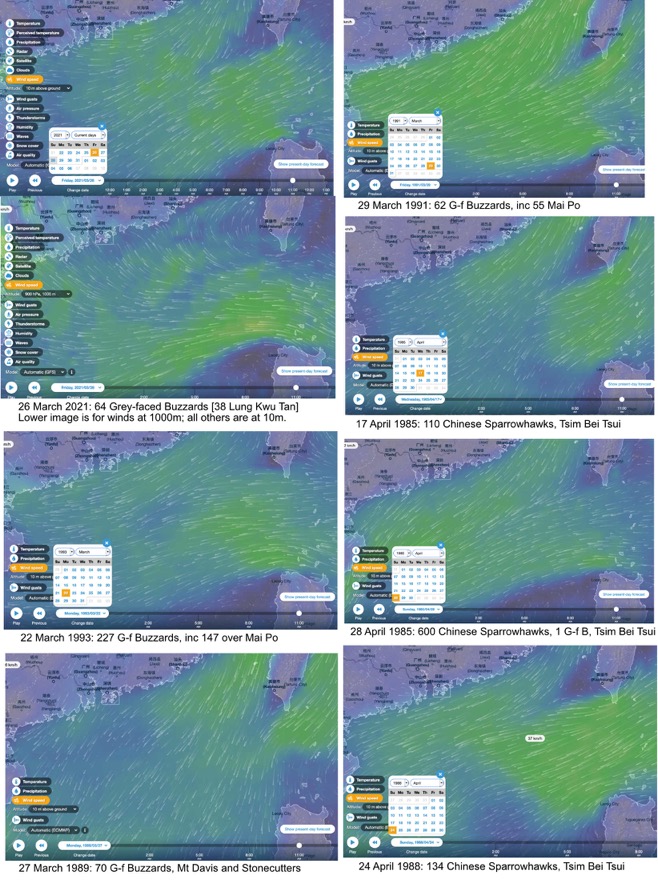
Checking the weather for these days, it turned out they all followed northerly surges/ arrivals of the northeast monsoon – and there were easterly or northeasterly airstreams. So it seemed likely the raptors were following the oceanic flyway, after departing Luzon, and had been deflected westwards in these crosswinds.
While crosswinds might not seem ideal, choosing to depart Luzon with rising air pressure should ensure that the Grey-faced Buzzards and Chinese Sparrowhawks could cross the South China Sea in anticyconic conditions, without encountering adverse weather such as heavy rainstorms. Hence, they should be able to safely undertake this potentially dangerous journey – and being deflected westwards, and then needing to reorientate towards the north or northeast, would be a relatively small inconvenience.
Migration Waves Predictable … sometimes
Fairly soon after working on the migration paper, I was leading a bird tour here in late April, and on 24 April 1997 noticed the weather pattern looking suitable for Chinese Sparrowhawks [it was late in spring for Grey-faced Buzzards].
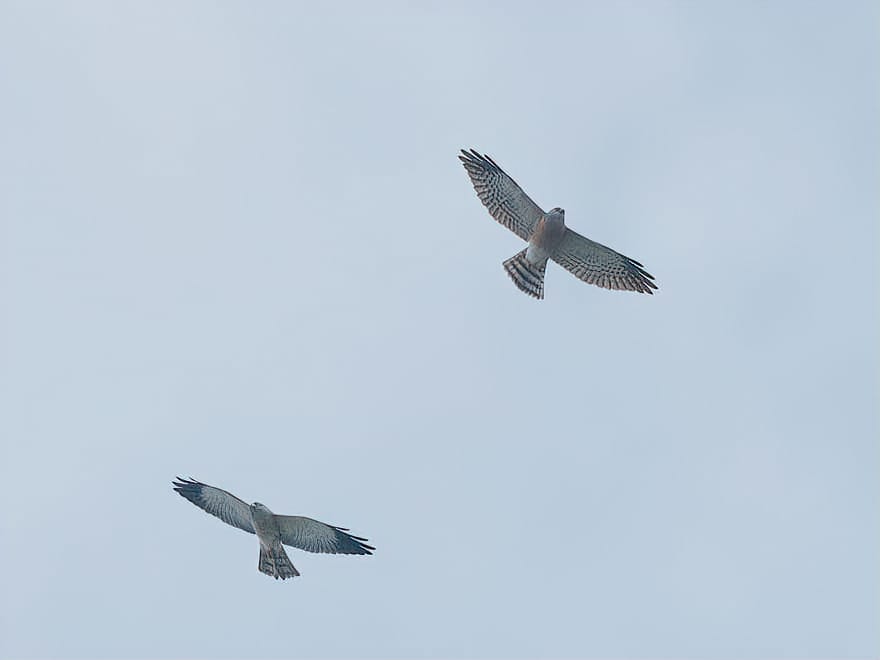
I suggested we try Tsim Bei Tsui to look for them, and this proved very successful: Chinese Sparrowhawks were passing low over the hillsides as we arrived, and we watched a succession of them heading north or northeast along the low hills, then north across Deep Bay towards Shenzhen. We recorded 216 that morning.
Travelling the Oceanic – Ring of Fire – Flyway
I remember back in the 1980s, before heading to China to study bird migration at Beidaihe, being told of recently discovered bird of prey migration between Taiwan and the Philippines, crossing a wider stretch of sea than is typical for birds of prey. This lies along the route now dubbed “the world’s major oceanic raptor migration system” (Over-ocean raptor migration in a monsoon regime: spring and autumn 2007 on Sangihe, North Sulawesi, Indonesia).
Usually, migrating birds of prey will travel long distances to avoid substantial sea crossings – for instance, following routes down past the western and eastern Mediterranean; while in Asia birds such as Crested Honey Buzzards breeding in Japan travel to and from winter quarters in Indonesia and nearby along a long, looping route via southern Thailand.
But for many Grey-faced Buzzards and Chinese Sparrowhawks breeding in northeast Asia, their main migrations are along the oceanic flyway – with the lengthy sea crossings and risks this entails.
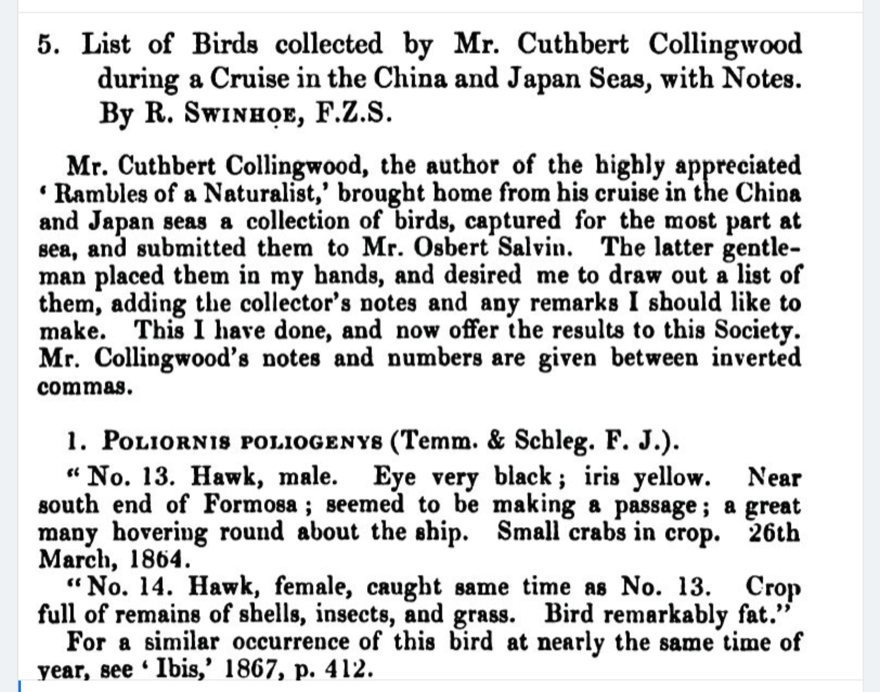
Knowledge of this flyway has greatly increased since the 1980s; and along with it, there is more appreciation of these wonderful travellers.
That’s especially the case in Taiwan – where birds of prey including Grey-faced Buzzard were formerly hunted, even slaughtered en masse, initially for food and later also to provide skins that could be mounted and sold to people in Japan. As an article on the Birding in Taiwan website notes, “Between 1976 and 1977, sixty-thousand Grey-faced Buzzard Butastur indicus skins were shipped to Japan.” But in the late 1970s and early 1980s, as the article relates, conservation measures substantially reduced the hunting, while boosting awareness of the Grey-faced Buzzard’s plight.
Since then, many people have headed to watchpoints in Taiwan to enjoy the migration of Grey-faced Buzzards, along with Chinese Sparrowhawks; and to count them each spring and autumn. In autumn 2021, a record 110,000 were recorded passing south over Taiwan (Record-high gray-faced buzzards seen in Kenting in annual migration); the record for Chinese Sparrowhawks may be 409,000 in autumn 2004.
The latter figure is cited in a paper on surveys of migratory birds of prey passing over Sangihe – an Indonesian island between Mindanao in the southern Philippines, and Sulawesi in Indonesia – in 2007. Here, the most abundant birds of prey were Chinese Sparrowhawks, with 225,067 in autumn; followed by Grey-faced Buzzard, with 4710 in autumn (Over-ocean raptor migration in a monsoon regime: spring and autumn 2007 on Sangihe, North Sulawesi, Indonesia).
There are several papers on studies of these raptors, at scattered locations along this flyway – such as Sangihe in the Philippines; southern Mindanao and north Luzon in the Philippines (see Spring Migration of Diurnal Raptors in Northern Luzon, Philippines, along the Oceanic Flyway in 2015 and 2016, though only the abstract is not paywalled); Taiwan; and Japan. Each contributes to our still patchy knowledge of the flyway.
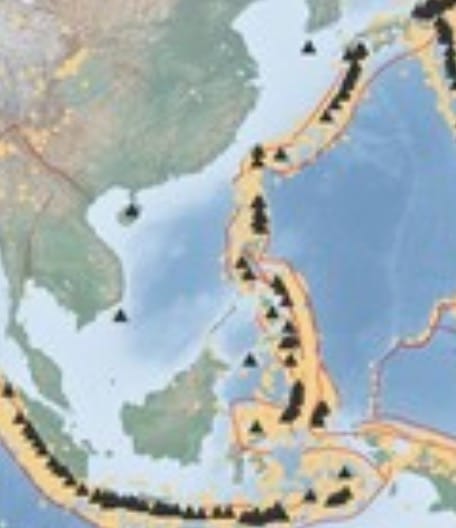
There are many smaller islands along this flyway – which largely follows a major arc along the “Ring of Fire”, with islands formed by volcanic activity along a major tectonic plate boundary. These can help serve as “stepping stones” – perhaps helping the raptors navigate, along with affording places to catch thermals to ride higher and save some energy by using more gliding flight, as well as roosting sites.
Even so, as noted in a study of grey-faced buzzards following the flyway, “the long distances of up to 300 km between the islands, which is more than distances commonly covered by raptors over water along other flyways, indicate that additional factors, such as atmospheric currents, facilitate raptor migration.” The researchers assessed the autumn migration of Grey-faced Buzzard travelling from Japan to the Philippines, and found that while the route with minimum water crossing looped somewhat west to include Taiwan, the birds actually took a rather shorter route, passing over the ocean east of Taiwan.
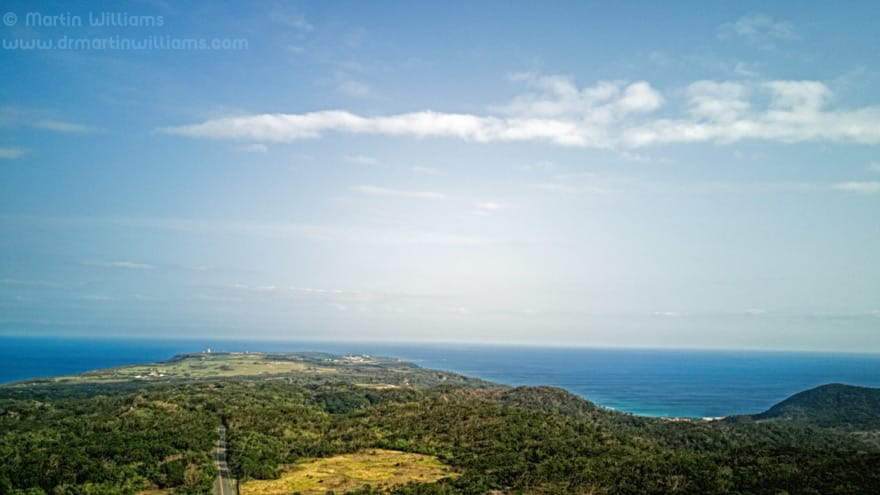
In Taiwan, considerably more Grey-faced Buzzards and Chinese Sparrowhawks are observed in autumn than in spring [I’ve been to Kenting at the southern tip of Taiwan in late April; looked for Chinese sparrowhawks but saw only around three…]. Hence, it appears plausible that in spring many follow the more continental route via Thailand. Yet this is not borne out by a very few tracking studies that show Grey-faced Buzzards heading north along the oceanic flyway. Also, a radar study of the spring migration of Chinese Sparrowhawks passing southern Taiwan found that many arrived over or near the southern tip at Kenting, and then headed northwest, over the sea, towards the mainland China coast.
The radar-tracked Chinese Sparrowhawks flew at around 50km/hr over the sea, though were slowed by crosswinds to around 40km/hr; and flew more slowly over land – around 35km/hr; and averaged around 300m above sea level when over the sea, and twice as high over land.
From 2008 to 2011, researchers in Taiwan caught 13 Grey-faced Buzzards, and fitted them with transmitters to follow their movements by satellite. While data was by no means complete for all individuals, the study was highly informative, including showing them travelling the oceanic flyway. And as Hong Kong birder Geoff Welch has noted, a track for one of these birds seems especially notable for Hong Kong.
This track is referred to in a media article:
The tracking study found that Cape No. 1 flew from Kenting to Mindanao in the southernmost Philippines to winter. When it was ready to fly north again this March it was hampered by several days of strong northeast monsoon winds, but it fought its way across the sea and reached a small island off the coast of the mainland’s Guangdong Province, where it rested and regained strength before continuing its journey.
Migratory routes of gray-faced buzzards tracked
The study is also outlined in an online article [in Chinese] – 展翼海角天涯,衛星天眼尋蹤
灰面鵟鷹衛星追蹤研究, which includes this map:
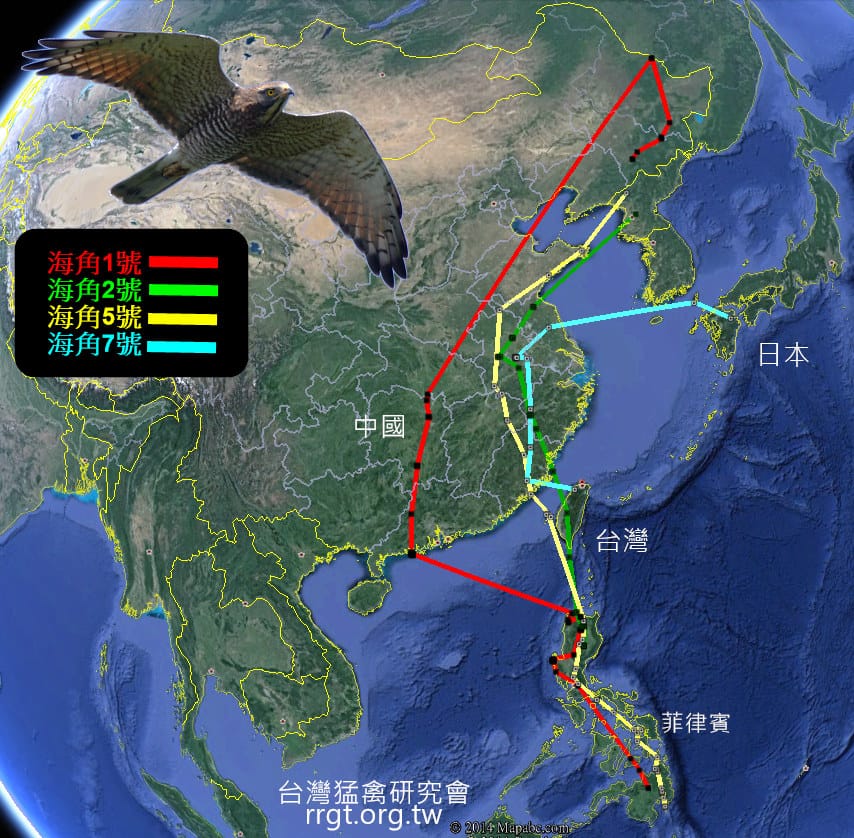
This bird was deflected even further west than Hong Kong – making landfall around 900km from its departure point on Luzon. Even if it flew directly at 40km/hr [based on the speed for Chinese Sparrowhawks in adverse crosswinds], this journey could have taken around 22 hours.
And non-stop flights, even if not following a straight line, seem likely for birds that depart from Luzon and arrive in vicinity of Hong Kong – as there might be just one islet en route. [Some may land on oil rigs? A small proportion, maybe.]
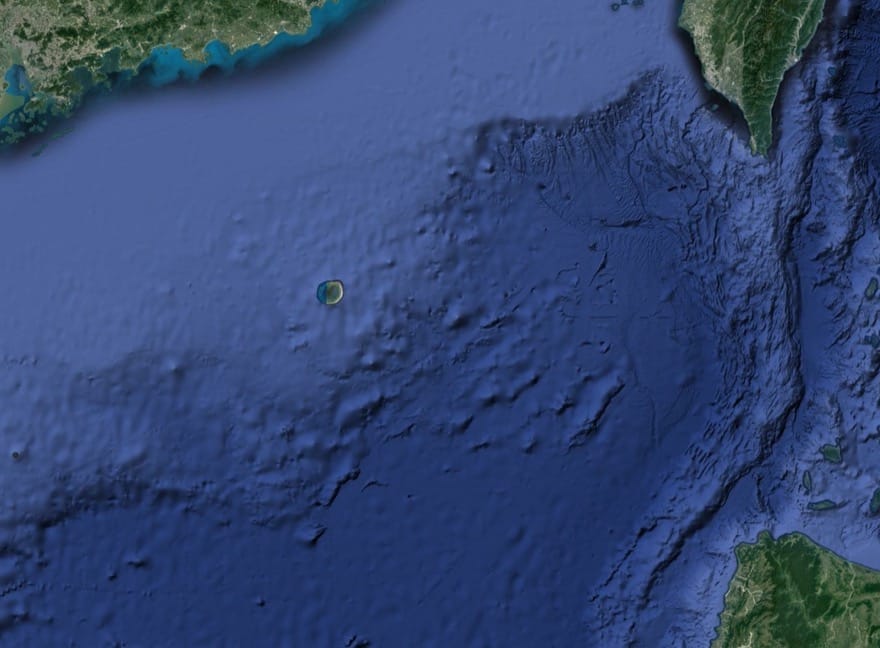
South China Coast Including Hong Kong as “Safety Net” for Raptors
A flight lasting almost a day, much of it at night, is quite an endurance feat for a bird of prey. Yet the fact that Grey-faced Buzzards and Chinese Goshawks can be seen in tens or hundreds over Hong Kong on some spring days – with surely many more occurring close by – suggests they are not simply wayward vagrants.
Instead, perhaps, these birds can rely on reaching the coast as a sort of safety net if deflected westwards – they are not simply headed to their doom over some empty ocean. And choosing to migrate during easterly winds, with rising air pressure, should mean they won’t encounter dangerous downpours or other potentially lethal weather events like bands of thunderstorms that can affect the area in spring.
So my guess is that being deflected in easterlies associated with anticyclonic conditions – rather than struggling to keep a northward track – is part of these raptors’ migration strategy. Can make landfall, tired but alive; rest, and reorient towards the breeding grounds.
Given this, might also guess that Chinese Sparrowhawks nesting in China around due north of Hong Kong might follow just such a route. Yet a tracking study – Annual Long-Distance Migration Strategies and Home Range of Chinese Sparrowhawk (Accipiter soloensis) from South China – found that they instead follow the route via Thailand to and from their winter areas in Indonesia.
Why? Maybe the population that colonised South China always used the more continental route.
But also, how do Grey-faced Buzzards and Chinese Sparrowhawks “decide” which of the two routes to follow; is there some sort of boundary between populations choosing Option A and those that choose Option B, even though their breeding and winter ranges may overlap?
Amazing Morning for Chinese Sparrowhawks passing Po Toi
Hong Kong’s record count for Chinese Sparrowhawk [which used to be known as Chinese Goshawk] was on 14 April 2010. As Geoff Welch related:
1440 Chinese Goshawks flew through Po Toi this morning between 9.30am and 11.30am, a spectacular sight.
Unlike the previous high count of 780 on 16th April 2006, which could only be seen from the highest point of Po Toi, this movement took place right through the harbour, the birds passing at heights mostly below 200 feet in a steady steam with more than one thousand birds between 10.30 and 11.30am.
Chinese Goshawk Spectacular on Po Toi
…
These birds will have been migrating north across the South China Sea between the Philippines and East China/Taiwan when they came up against the cold front which passed through Hong Kong on Tuesday afternoon and were driven west by the strong NE winds towards the coast of South China. They probably made landfall on the Dangan Islands late yesterday and overnight, then resumed their migration this morning to reach Po Toi in the late morning.
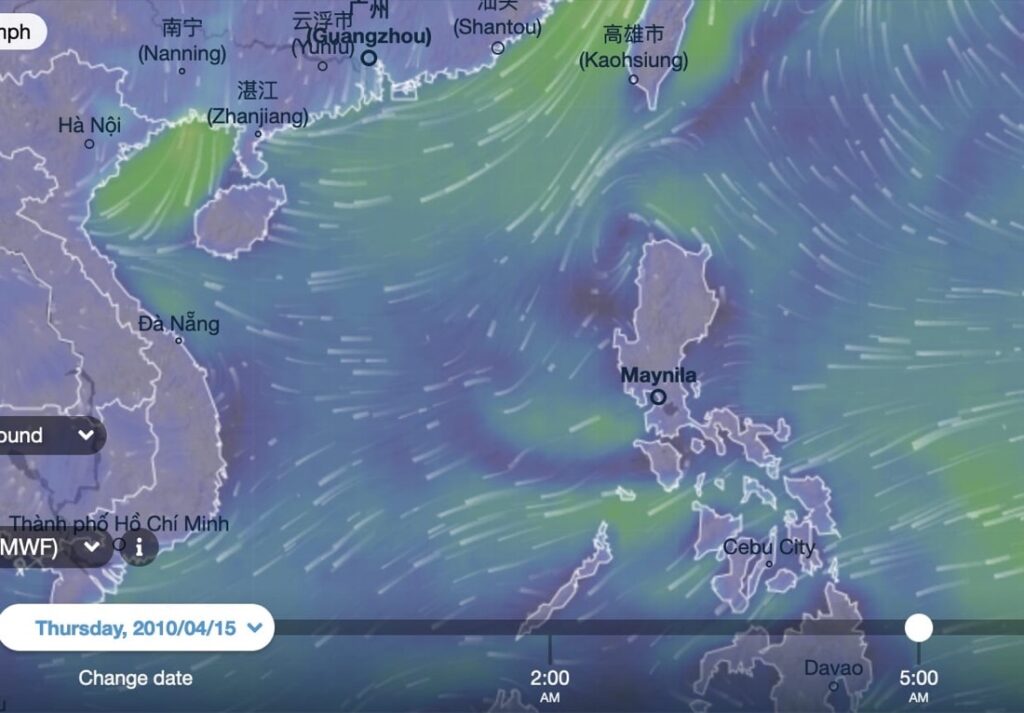
As with the above-mentioned movements of Grey-faced Buzzards and Chinese Sparrowhawks – which were in years before Po Toi was recognised as a migration hotspot, particularly thanks to dedicated efforts by Geoff Welch – there were easterly/northeasterly winds prevailing over the South China Sea.
Also, as the chart indicates, the winds were stronger over the Taiwan Strait, which can be a little like a “wind tunnel” with stronger winds than nearby areas – in turn making it harder to push directly north in such conditions.
Other notable sightings of these raptors at Po Toi have also coincided with easterly airstreams; the second highest count was on 16 April 2006 – the day after a cold front moved south from China across the sea, when 780 passed over.
Spring Raptor Watchpoints in Hong Kong
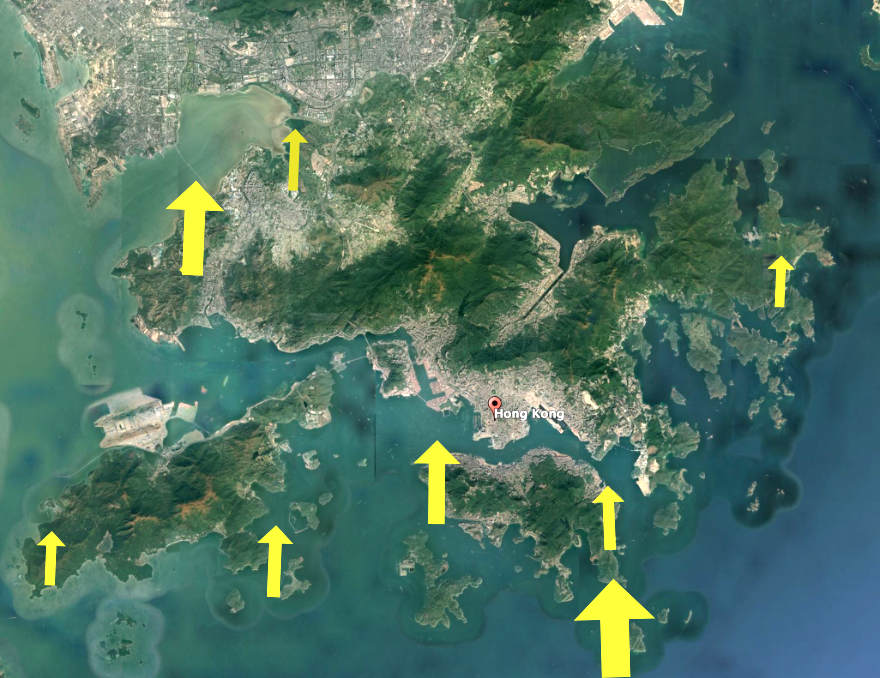
As the above information indicates, the places where Grey-faced Buzzards and Chinese Sparrowhawks have been recorded in fair numbers during spring are somewhat scattered. Often, the observations have been by happenstance: birders on outings who were lucky enough to see them passing. Po Toi and Tsim Bei Tsui are of course standouts; the former with more recent observations, the latter more around the 1980s and 1990s [when it was a very good place for seeing waterbirds in Deep Bay; growth of dense mangroves has since obscured much of the view].
However, in spring 2022, Lantau proved very good for raptor observations.
Lantau a Hotspot for Raptor Observations in Spring 2022
I live on Cheung Chau, and have sometimes seen migratory birds of prey passing over the island, occasionally in fair numbers. But other places like Tsim Bei Tsui have proven far better. Envisaging birds seen there included a substantial proportion that had made landfall west of Hong Kong, then followed the coast towards the east or northeast across the Pearl River, I tried watching from Tai O on the west coast of Lantau in spring 2021: nothing!
Autumn 2021 led to finding that Nam Shan and nearby Tai Ngau Wu Shan can be good vantages for migrating birds of prey; and I tried the latter with some success during easterly airstreams in March 2022:- with 33 Grey-faced Buzzards flying north on 30th, and 19 the next day. Yet also on 31 March, Lantau-based birder Paul Aston watched from Ngong Ping View Point, at Windy Gap (Tai Fung Au), and saw rather more Grey-faced Buzzards along with other species such as Silver-backed Needletails.
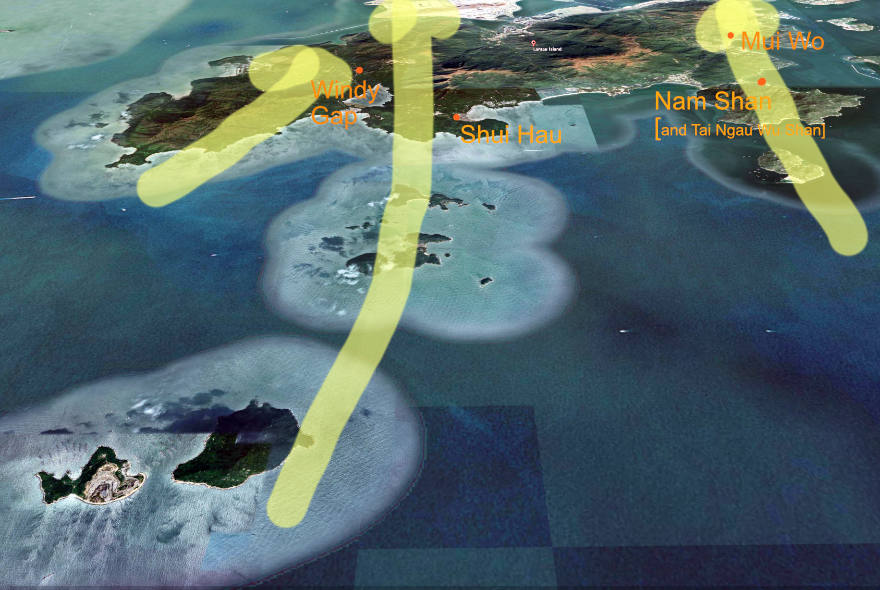
I headed up to Windy Gap, and – along with Paul and others – have found it can indeed be productive for migrating birds of prey. For myself, I currently even favour the somewhat higher Lion Head Mountain, Sze Tsz Tau Shan, partly for more chance of birds passing at eye level.
Observing here, it’s clear that my notions of raptors mainly following coastal routes over islands and low hills is wrong: Grey-faced Buzzards and Chinese Sparrowhawks may have approached Windy Gap and Lion Head Mountain from lower down, maybe appearing over Shek Pik Reservoir, but have also readily risen to pass over the hills, and on fine warm days even soar on thermals to pass high over Ngong Ping, maybe well above 600m (Lion Head Mountain rises to 493m).
See also Birds of Lion Head Mountain and Ngong Ping on Lantau, Hong Kong.
Why Windy Gap and Ngong Ping Area on Lantau?
When I first joined Paul at Windy Gap, and wondered why it seemed good for passing birds of prey, he said they would be looking for mountains, as on Lantau. I didn’t think so; know from experience hills can be like magnets for soaring birds like these, but I was still wedded to notion of birds of prey passing Hong Kong along lower, coastal routes. My first hours watching here, on two or three days, convinced me I’m wrong: it seems Grey-faced Buzzards and Chinese Goshawks do head for Lantau.

The above photo shows that Lantau hills are prominent landmarks for birds approaching from the south.
As they approach Lantau, the Soko Islands just might serve as further landmarks/ “stepping stones” to the south coast near Shui Hau [see above, with apparent routes].

This panorama gives something of a bird of prey’s eye view of the Ngong Ping area approached from the south. Almost like a “wall” to fly around, or pass over; and we have seen birds passing over. Those viewed from Windy Gap/Lion Head Mountain have headed to the west of Lantau Peak; many flying towards Ngong Ping, gaining height as they approach, and maybe then soaring higher on thermals above Ngong Ping and moving off towards the north.
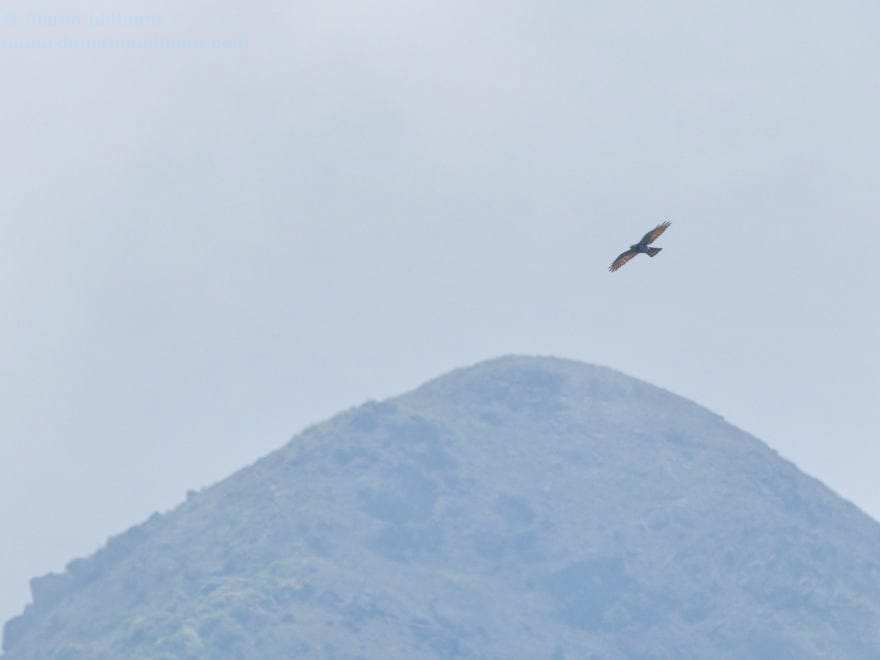
On a couple of mornings, as passage began, Chinese Sparrowhawks – especially – have flown rather lower, some passing between Kwun Yam Shan and Windy Gap. Later, with thermals better developed, perhaps favouring the higher route over Ngong Ping, which is more directly northwards.
For anyone interested in trying: Windy Gap is easily reached by bus to Ngong Ping. Alight at the stop just after the junction with Sham Wat Road, and walk up Ngong Ping Road maybe five minutes, looking for a pavilion on the right. [The pavilion also affords shade from intense sun; maybe rain, though rainy weather is liable to be poor for birds of prey.]

From observations including from Windy Gap, I believe Lion Head Mountain [Sze Tsz Tau Shan] is a better vantage overall; partly for higher chance of birds passing at eye level: affording superb views and photo opportunities. As this panorama shows, there are expansive views to the south; views across Ngong Ping to the north are also excellent.
Lion Head Mountain is not quite so easily reached: maybe 15-20 minutes’ walk from Ngong Ping bus terminus, along narrow road at west of Ngong Ping area, then a rough track across scrubby hillside.
See also Birds of Lion Head Mountain and Ngong Ping on Lantau, Hong Kong, mainly for photos of various species seen and photographed there.
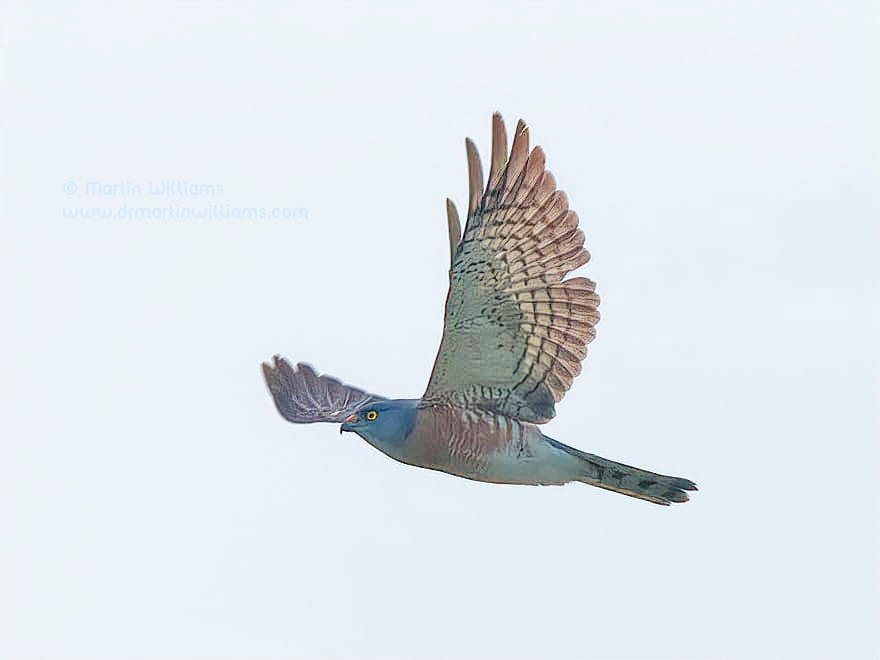
This Chinese Sparrowhawk, say, was among a few I’ve seen passing Lion Head Mountain at eye level.
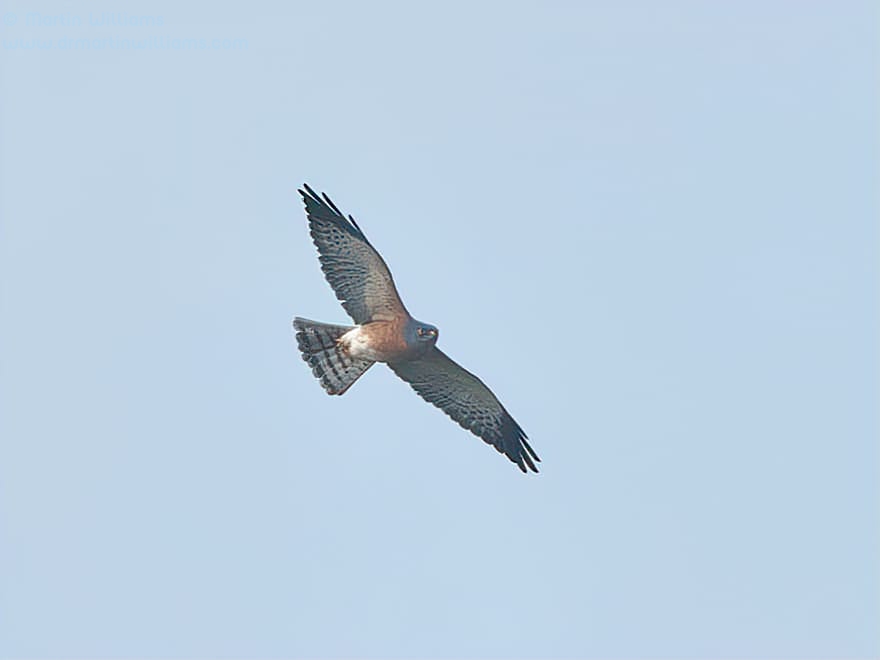
Especially later in the morning, birds also soared above Lion Head Mountain; one party went so high on the “elevator” of rising air, I could no longer see them with the naked eye.
Notable Days for Grey-faced Buzzards and Chinese Goshawks in Spring 2022
Spring 2022 was productive for Grey-faced Buzzards and Chinese Goshawks passing Hong Kong. This is partly because there have been relatively high numbers of days with easterlies prevailing over the South China Sea; also as there has been more effort than usual in watching for them (partly, with Covid restrictions, can’t readily go off on birding trips outside Hong Kong; and interesting to try something locally that’s “off the beaten track” birding-wise).
Notable days include:
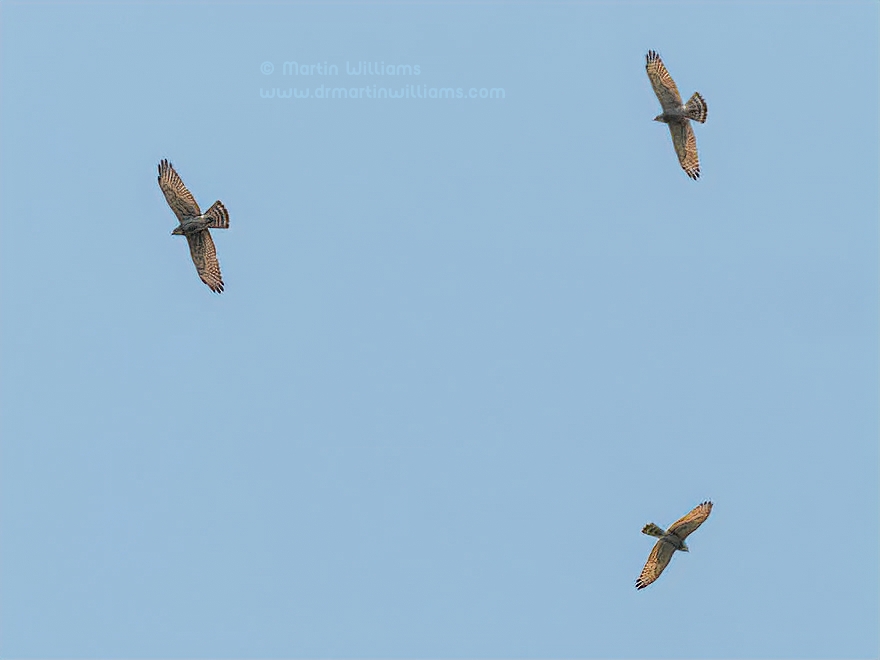
8 April 2022 I saw 116 Grey-faced Buzzards heading north, from Windy Gap vantage. Arrived there around 9am; was set to leave at around 12.30pm, when passage seemed to be over – but walking down to bus stop saw a flock of 29, plus 2 more; walked back to vantage and there were 12 just above. I stayed on till after 2.30pm, but only another four individuals seen.
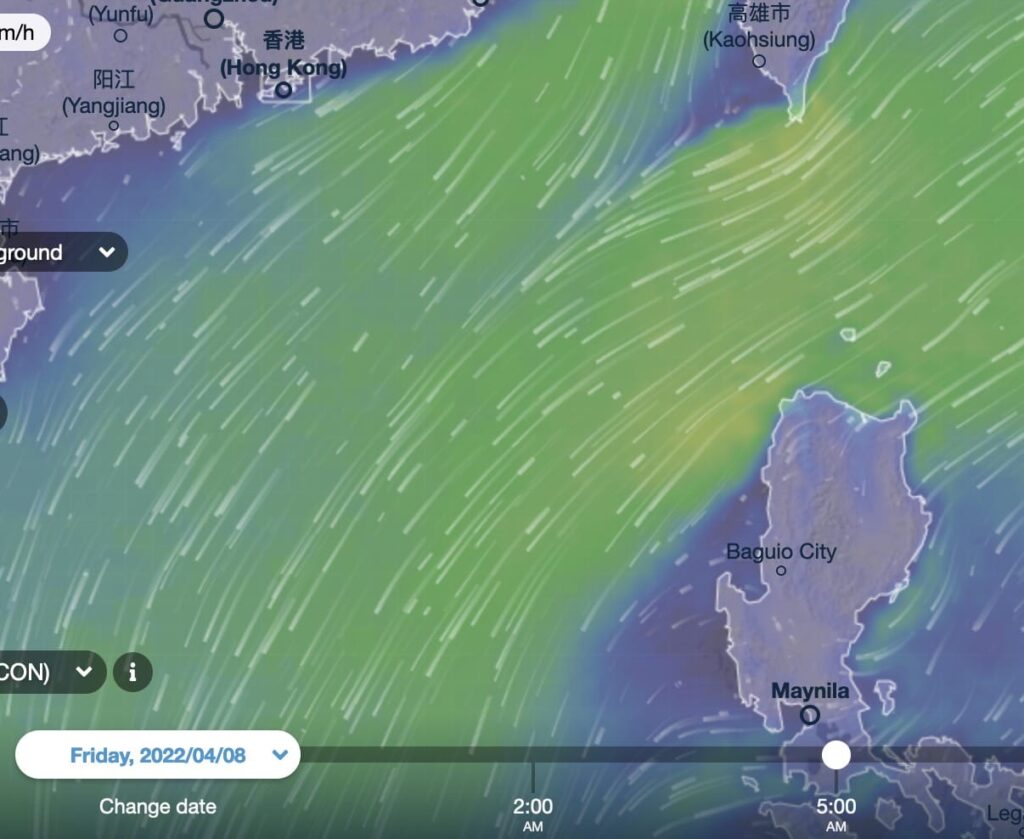
20 April 2022 Substantial passage of Chinese Sparrowhawks over Hong Kong in the morning, seen from several locations including Windy Gap, with reports via whatsapp [yet to be full official reports for HK Birdw Soc perhaps]:
400 over Wong Chuk Yeung, Sai Kung [BosChan]; 10 from Ting Kok [Matthew Kwan]; 5 at Tseung Kwan O [afternoon, Akki]; 164 from Mount Butler, Hong Kong Island [Akki and Robert Harkel]; 2 at Lamma [Mike]; 90 over San Tin [John Holmes]; 5 Ho Pui Village [John Clough]; 1 at Tai Tong [John Chow]; 5 from Cheung Chau [me]; 43 from Mui Wo [Paul Aston]; 180 from Windy Gap [Edward Yip]. Total 905 – perhaps second highest day total for Hong Kong, though also the first day with good numbers seen in widespread locations. [No Po Toi observations….]
Also Grey-faced Buzzards:
51 from Mount Butler; 6 over San Tin; 1 over Tai Tong; 5 from Mui Wo; 12 from Windy Gap. Total 84.
As seems typical, most birds passed in the morning, from around 8am-12.30pm, mainly 9.20-11.20am.
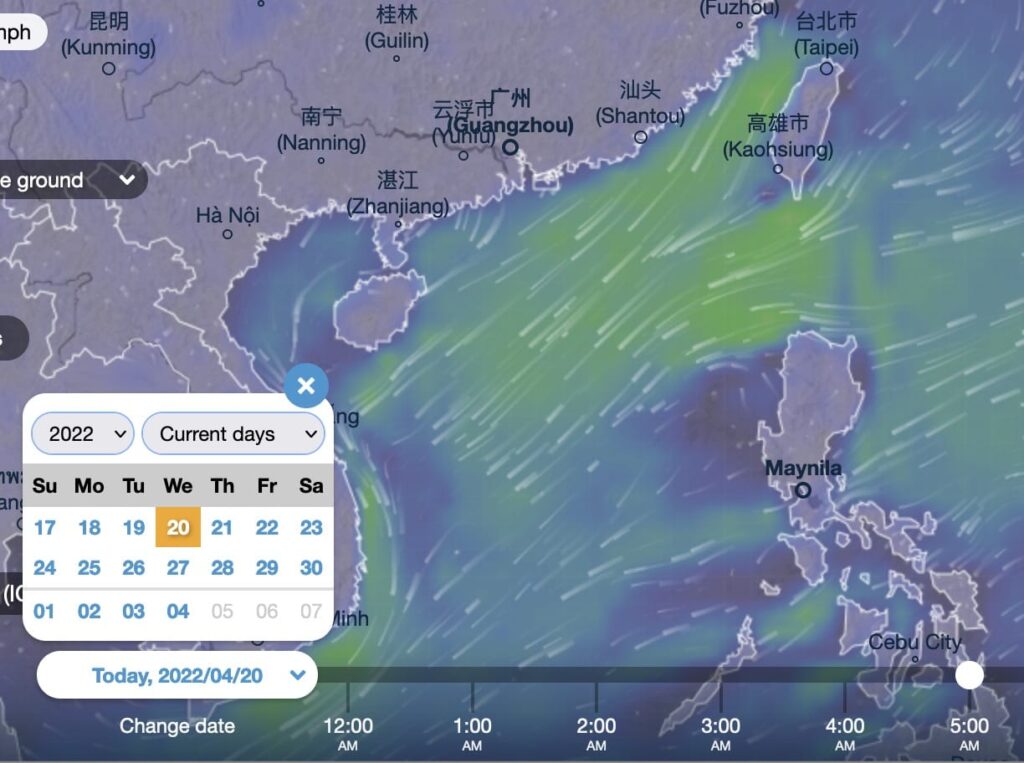
[I had tried Nam Shan, se Lantau, the morning before. It was overcast, chill, with a little drizzle. No birds seen migrating by 9.30am, so I gave up n went home. Can wonder if at least some Chinese Sparrowhawks waited out this day, till weather improved on 20th.]
21 April 2022 c 90 Chinese Sparrowhawks and 112 Grey-faced Buzzards from Windy Gap [Paul Aston] and Lion Head Mountain [me]. Again, morning passage; numbers tailing off after 11am.
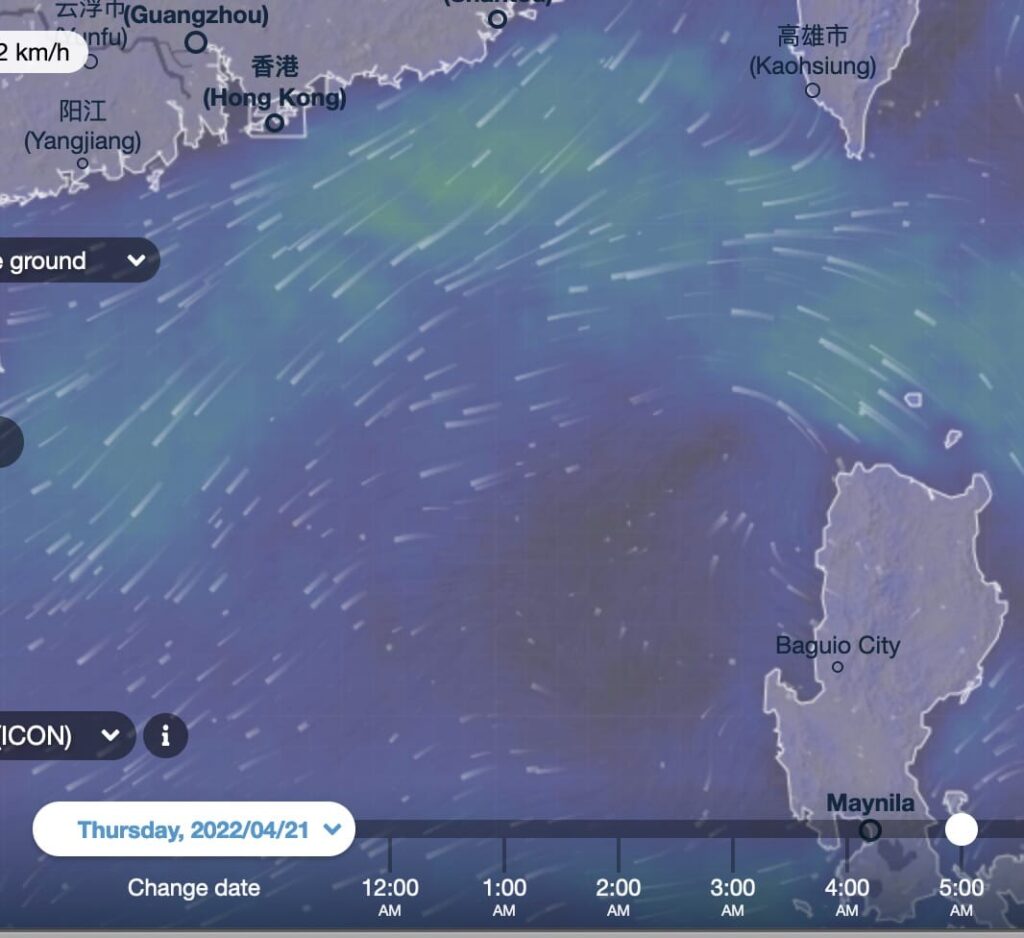
3 May 2022 2 Grey-faced Buzzards and 101 Chinese Sparrowhawks flew north past Lion Head Mountain, Lantau. The next morning, five were seen from the same vantage; and the following day, none. The airstream remained broadly easterly; maybe the sparrowhawk “waves” are also more prompted by changing weather, such as rising air pressure?
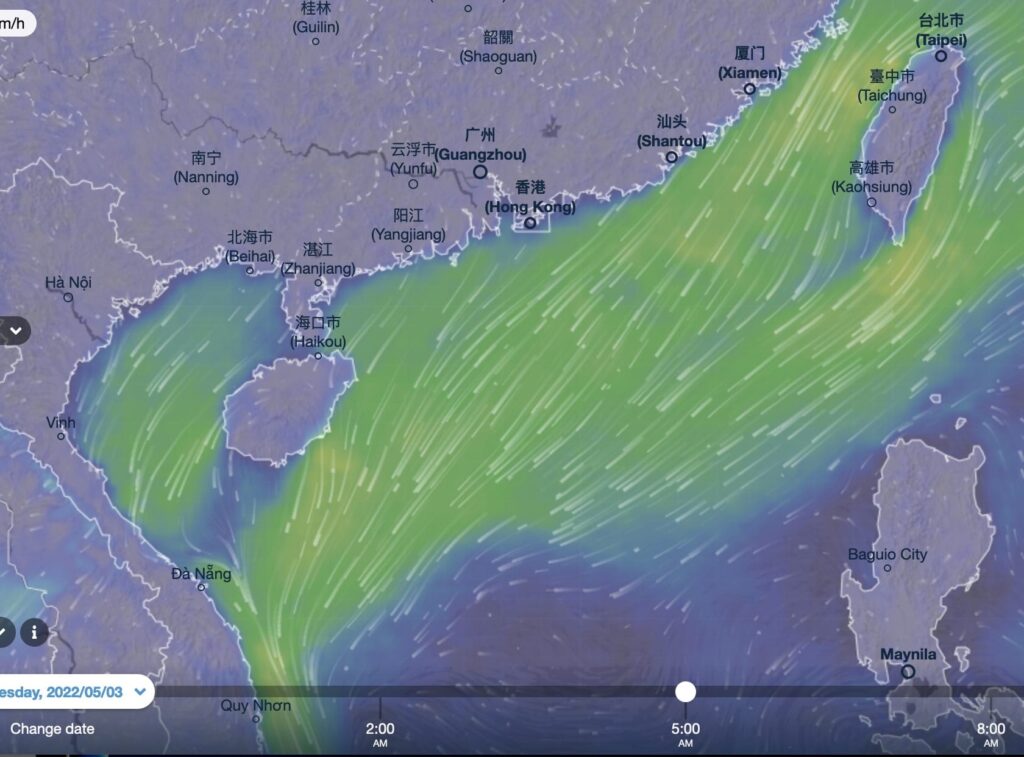
Island Rest Stops for Tired Migrants
Geoff Welch has suggested many of the Grey-faced Buzzards and Chinese Sparrowhawks passing Po Toi in spring have rested overnight on the Dangan Islands, a little further south [in Zhuhai].
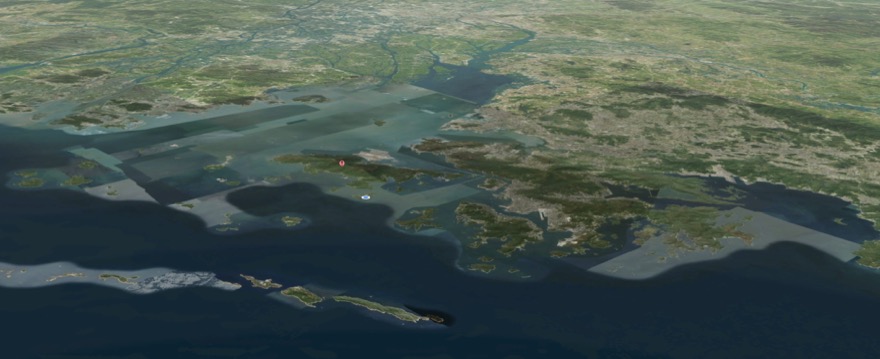
This seems highly plausible; and for these raptors seen passing Lantau this spring, it seems they are headed from south to north, with those over Windy Gap and Ngong Ping perhaps including birds that had flown over the Soko Islands to near Shui Hau [where Jay saw parties of 9 and 11 Grey-faced Buzzards flying overhead one morning; shortly before I saw parties of 9 and 11 pass Windy Gap].
It’s tempting to speculate that, by contrast, birds seen passing over the Sai Kung area have roosted on islands south of the Sai Kung Peninsula.
As noted above, if these birds have arrived by non-stop flights from Luzon, they might have been in the air for over 20 hours. Based on studies elsewhere along the flyway, they likely departed in the early morning, so may arrive in the Hong Kong area before dawn. Given fine weather they might be impelled to move on northwards after a relatively short rest – departing after 9am it appears, some later than this. Then, onwards and northwards, hopefully to find somewhere to feed as well as rest.
Possibly…
Surely interesting if can learn more; I even wonder if some that arrived non-stop just keep on going if conditions suit them.
Of course, we don’t know they do arrive non-stop from Luzon or nearby; though as noted above, there’s a dearth of places to halt en route.
There’s more to learn, perhaps over a span of some years given these “waves” of Grey-faced Buzzards and Chinese Sparrowhawks are infrequent here.
Other Birds at Windy Gap / Ngong Ping Area
Also in April 2022, the Windy Gap / Ngong Ping area proved good for sightings of Bonelli’s Eagle, a scarce bird in Hong Kong. Maybe just one individual; not sure. Also Crested Serpent Eagle, with perhaps some migrants and a seemingly territorial male. White-bellied Sea-Eagle seen too; also Crested Goshawk displaying, and a Besra apparently migrating past.
Also on this site, see Birds of Lion Head Mountain and Ngong Ping on Lantau, Hong Kong, with some info plus photos.
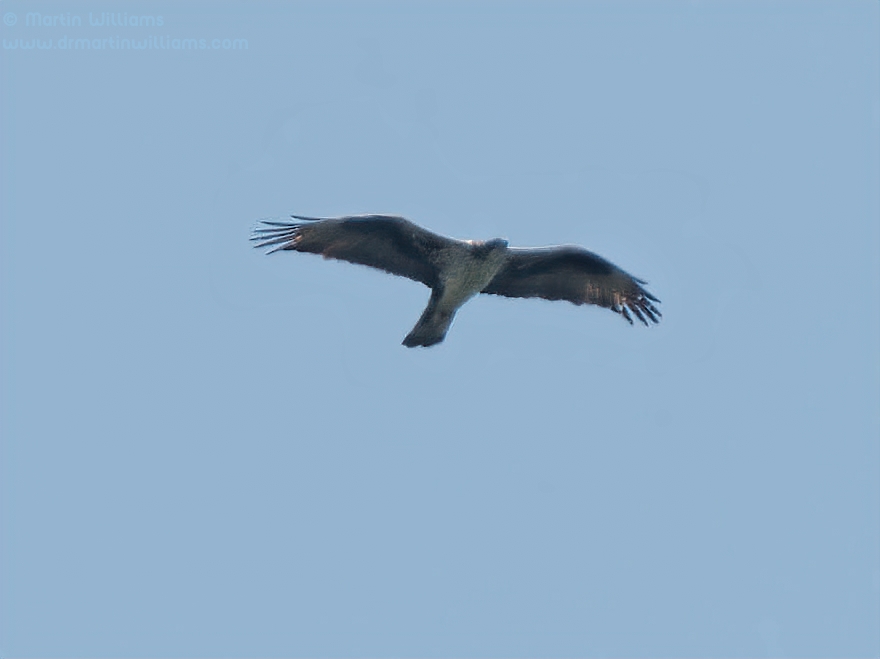
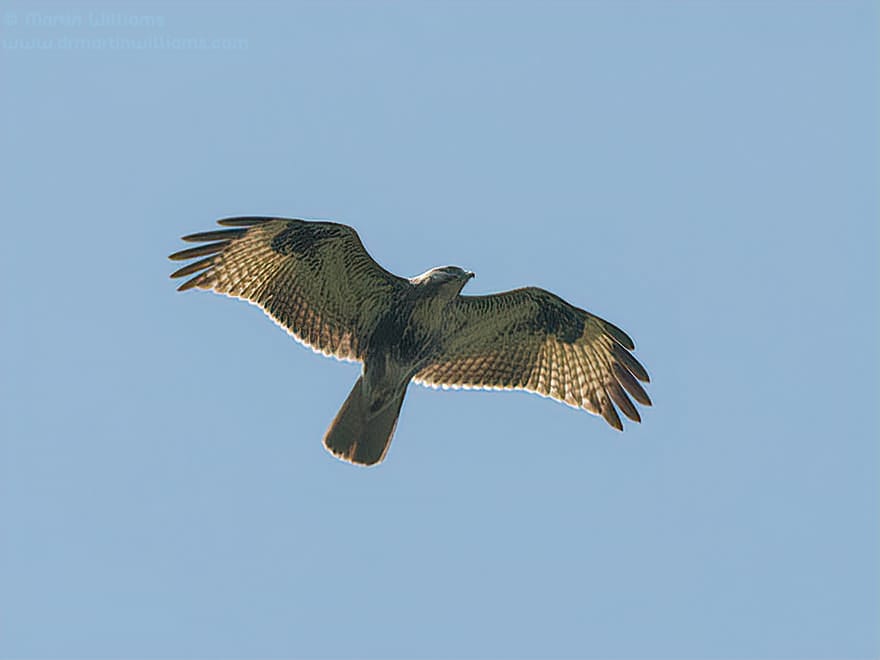
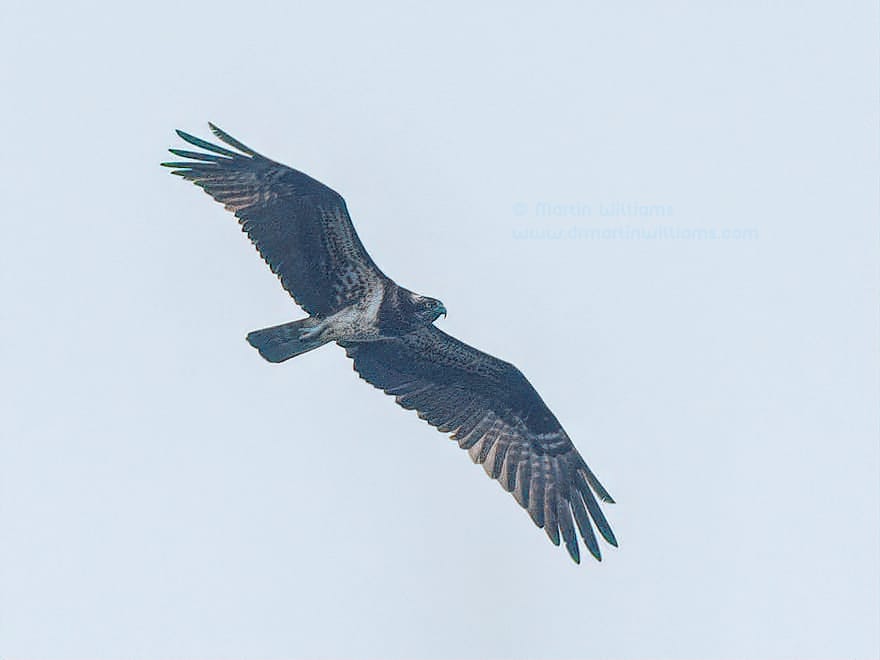
An Osprey and three Eastern Buzzards have also passed by. These are among migratory raptors that reach the Philippines for winter, and as they occurred along with Grey-faced Buzzard and Chinese Sparrowhawk movements, at a time when it is not easy to find either species on Lantau, they too just may have travelled from Luzon. Maybe.
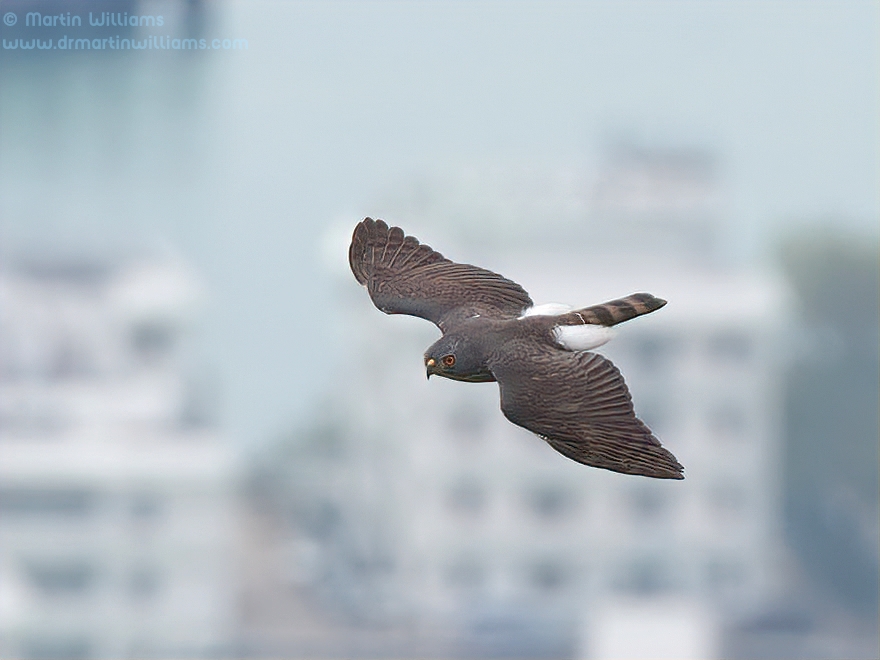
House and Pacific swifts are regular in small numbers, the latter maybe breeding. On 4 April, a party of six Blue-tailed Bee-eaters flew north: surprised me, especially given they were headed up and over hills, rather than over lowlands as seems typical for bee-eaters in Hong Kong.
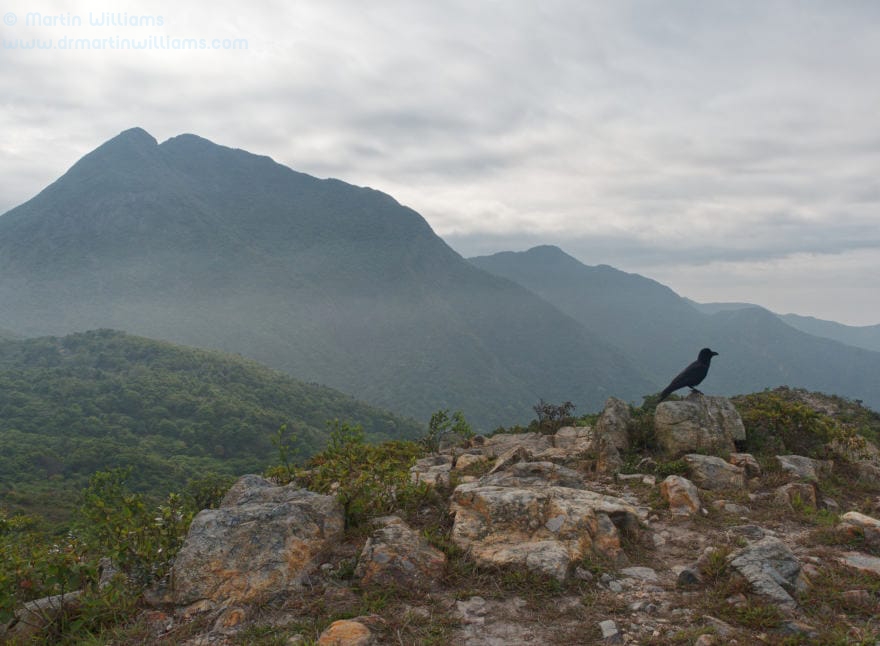
Also, a very confiding Large-billed Crow, maybe thinks itself king or queen of Lion Head Mountain; landed within about 4m from me one morning, when I took this wide-angle shot.

Very interesting, and respecte for the patience to study migration sightings that can be many years apart.
Thanks Hamish!